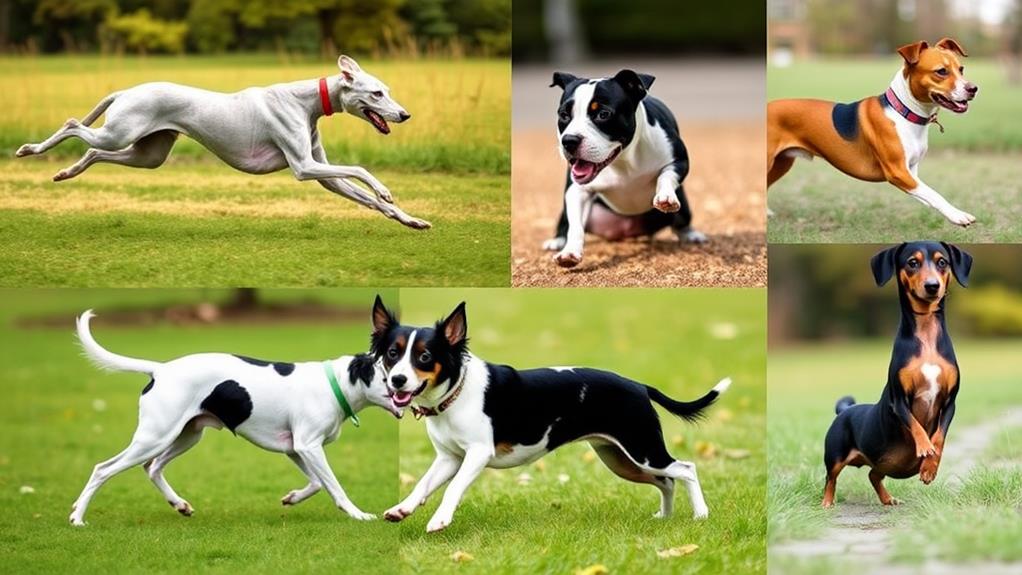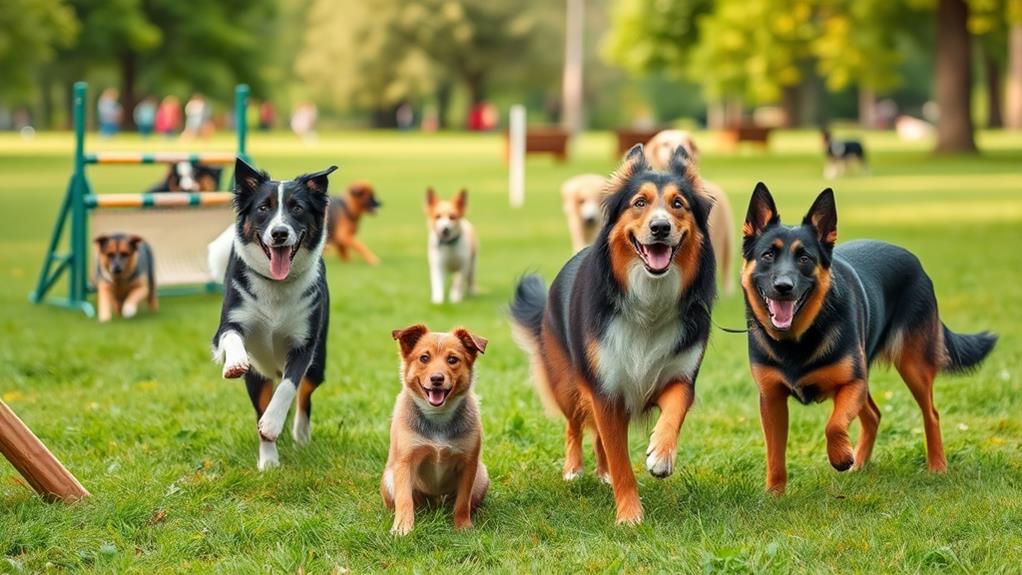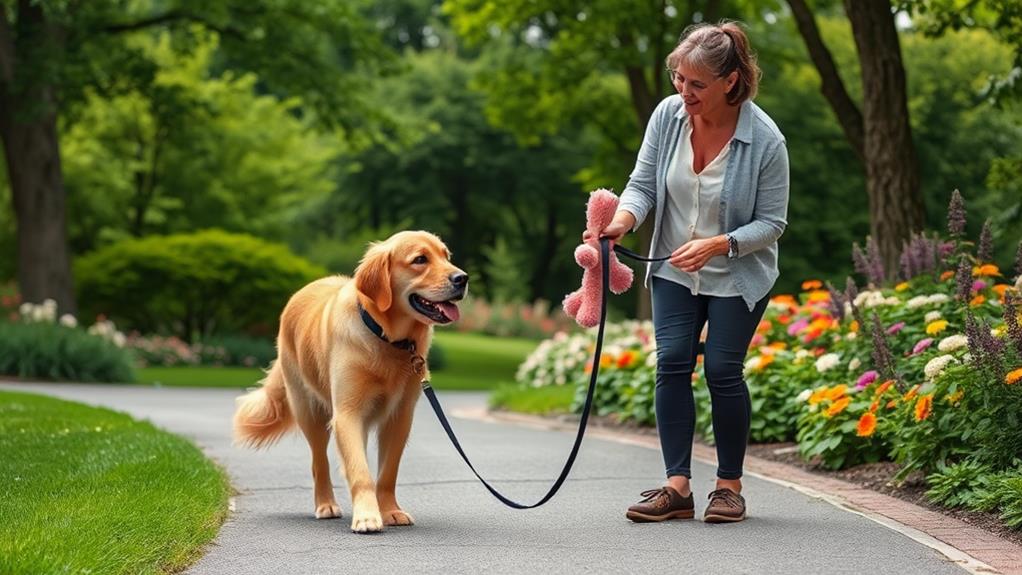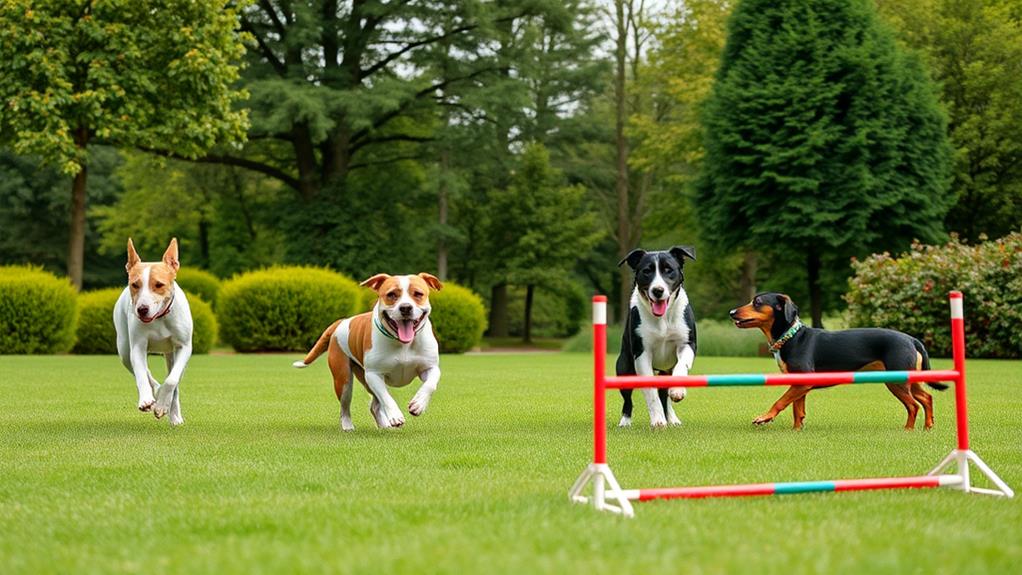Customized exercise plans are vital for your dog's health, considering their breed, age, and energy level. High-energy breeds like Border Collies need vigorous activities, such as brisk runs or agility training. For low-energy breeds, moderate exercise like leisurely walks suffices. Smaller dogs benefit from light play and short walks, while senior dogs require gentle, low-impact activities, like swimming and short hikes. Regularly monitoring your dog's health and activity level guarantees they stay happy and active. Want to explore tailored activities and tips for your dog's specific needs? You're in the right place to learn more.
Understanding Breed-Specific Needs

When you choose a dog breed, understanding its specific exercise needs is essential for keeping your furry friend healthy and happy. Different breeds have varying energy levels, and knowing these can help you tailor your exercise routine. For instance, high-energy breeds like Border Collies or Vizslas thrive on vigorous activity, often requiring over an hour of exercise daily. Conversely, breeds like Bulldogs or Basset Hounds are more laid-back and may only need a moderate walk.
Pay attention to your dog's age, size, and health status as well. Puppies have boundless energy but shouldn't overexert themselves. Older dogs often require gentler, shorter sessions to prevent injury. Additionally, larger breeds may need more space to roam, while smaller breeds might prosper in compact areas.
It's also indispensable to contemplate the climate when planning exercises. Hot or cold weather can impact your dog's ability to engage in physical activity. Always monitor your dog for signs of fatigue or distress during exercise. By understanding and respecting your dog's breed-specific needs, you'll not only keep them fit but also strengthen your bond through enjoyable and appropriate activities.
Recommended Activities for Active Breeds

For active breeds, mixing up their exercise routine keeps things exciting and engaging. These dogs thrive on high-energy activities, so it's crucial to incorporate a variety of exercises that challenge them physically and mentally. Consider taking them on brisk runs or long hikes, allowing them to explore new trails and scents. This not only burns off energy but also satisfies their natural curiosity.
You can also introduce agility training, which is perfect for breeds like Border Collies and Belgian Malinois. Set up a course with jumps, tunnels, and weave poles, and watch them excel as they navigate through the challenges. Additionally, playing fetch with a frisbee or ball can provide a fantastic workout while strengthening your bond.
If you've got access to water, swimming is another ideal option. It's low-impact yet highly effective, perfect for keeping active breeds fit while reducing joint stress. Ultimately, consider setting up playdates with other dogs to encourage socialization and stimulate their playful nature. By incorporating a mix of these activities, you'll keep your active breed happy, healthy, and well-exercised.
Gentle Exercise for Smaller Dogs

Smaller dogs may not require the same intensity of exercise as their larger, more active counterparts, but they still benefit from regular physical activity. Gentle exercise is imperative for your little furry friend to maintain a healthy weight, strong muscles, and mental stimulation.
Daily walks are a great way to start. Aim for short, leisurely strolls that allow your dog to sniff around and explore their environment. Since smaller breeds can tire easily, keeping these walks to around 20-30 minutes is ideal.
Additionally, incorporating play sessions with toys or engaging in light fetch can be delightful and beneficial. Consider activities like agility courses or obstacle courses designed for small dogs. These can provide both physical and mental challenges in a fun, safe way. Indoor play is also a fantastic option, especially during inclement weather. Use toys that encourage movement, like soft balls or tug ropes.
Adapting Plans for Senior Dogs

As dogs age, their exercise needs change substantially, requiring you to adapt their activity plans to suit their capabilities. Senior dogs often experience reduced energy levels, joint stiffness, and overall decreased mobility. To keep them healthy and happy, you'll want to focus on low-impact activities that encourage gentle movement without overexertion.
Here's a simple guide to help you create an exercise routine for your senior dog:
| Activity | Duration | Frequency |
|---|---|---|
| Short walks | 10-15 minutes | 2-3 times daily |
| Light playtime | 5-10 minutes | 1-2 times daily |
| Swimming | 15-20 minutes | 1-2 times weekly |
| Puzzle games | 10-15 minutes | Daily |
| Slow-paced hikes | 20-30 minutes | Weekly |
Monitoring Health and Progress
Regularly monitoring your senior dog's health and progress is crucial to confirming they remain comfortable and active. Keeping an eye on their well-being helps you adjust exercise routines and address any concerns early.
Weight: Regular weigh-ins can help you track changes. A sudden weight gain or loss may indicate health issues that need attention.
Mobility: Observe how easily your dog moves during walks or playtime. Stiffness or reluctance to engage can signal discomfort or pain.
Energy Levels: Pay attention to your dog's enthusiasm for exercise. If they seem less excited or tire quickly, it might be time to reassess their routine.
Incorporating these observations into your regular care can help you create a tailored exercise plan that meets their needs. Don't hesitate to consult your vet if you notice any concerning changes. Remember, your dog's health is dynamic, and staying proactive will guarantee they enjoy their golden years to the fullest. By monitoring these factors closely, you can foster a happy, active lifestyle for your beloved companion.
Frequently Asked Questions
How Do I Determine My Dog's Ideal Exercise Duration?
To determine your dog's ideal exercise duration, consider their age, breed, and energy level. Start with 30 minutes daily, adjusting based on their response. Keep an eye on their behavior for signs of fatigue or enjoyment.
Can I Combine Different Exercises for My Dog?
Did you know that dogs need at least 30 minutes of exercise daily? Yes, you can combine different exercises for your dog! Mixing activities keeps things fun and engaging, ensuring they stay healthy and happy.
What Signs Indicate My Dog Is Overexerted?
If your dog's panting becomes heavy, they're lagging behind, or they show signs of lethargy, it's time to stop. Watch for excessive drooling, staggering, or difficulty breathing, as these indicate overexertion and require immediate attention.
Are There Specific Toys That Enhance Exercise for Certain Breeds?
Yes, certain toys can enhance exercise for specific breeds. For example, herding breeds love chase toys, while retrievers enjoy fetch balls. Assess your dog's instincts and preferences to choose the right toys for ideal playtime.
How Can Weather Affect My Dog's Exercise Routine?
Weather can completely flip your dog's exercise routine! Rain can turn playtime into a soggy mess, while scorching heat can drain energy faster than a vacuum. You'll need to adapt activities for comfort and safety.
Conclusion
In crafting customized exercise plans for your dog, you're not just building fitness; you're nurturing a bond that runs deeper than a leash. By understanding their unique needs, you'll keep tails wagging and spirits high. Remember, whether your pup's a sprightly athlete or a gentle companion, every step together strengthens your connection. So lace up those shoes, grab a toy, and let the adventure begin—because every dog deserves a life filled with joy and movement!



